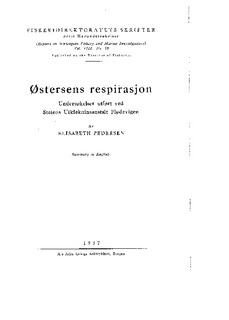| dc.description.abstract | In Norway the oyster, Ostrea edulis, is cultivated in small natural
salt-water ponds, with but narrow communications with the sea. On
the top of the ponds we have generally a layer of fresh water. The
temperature rises very high during summer - to 25° C or even higher.
In winter the ponds may be covered by ice for about 5 months. And
especially on the Skagerrak coast the temperature of the sea water
may approach zero. During summer the production of phytoplancton
is very high. And the quantity of oxygen produced may often exceed
150 per cent of saturation. In autumn the sunlight becomes scarce,
the oxygen will be consurned to a high degree, and hydrogen of sulphur
may occur in the bottom layers.
It will be understood that the oysters in these ponds must be in
possession of a great power of adaptation to different environments. In
the present paper are given the results of experiments on the consumption
of oxygen, and the production of carbondioxide by the oyster at
different temperatures.
The oysters used were taken from the same batch. They were
partly brought directly into the experiments, and partly kept for a
few days beforehand in filtered water, in order that they may rid themselves
of contents in the intenstines that might impair tlie analysis. Prior
to the experiments the oysters were brushed and washed with 40 per cent
alcohol, and oysters intended for use in series in the experiments were
numbered.
The experiments were performed in glasses containing 2 litres of
sea water. They were closed water-tight by means of glasslids, rubber
bands and springs. During the experiments the glasses had to be turned
in order to bring about circulation. To prevent small bits of shell to be
broken off and come into the analysis for carbondioxide, the oysters
were wrapped in pieces of gaze.
In each experiment were used several oysters, kept in separate
glasses. In order to eliminate the changes occasioned by the life processes
of the plancton and the bacteria in the sea water used, glasses
filled with the same water were included in the experiments. The results
then represent the difference betwecn the actual sample and the blind
proof.
The duration of each experiment varied according to the temperature.
Care was taken to stop the experiment before all the oxygen had
been consumed.
The results are given seperately for the individuels opened later,
to determine the net weight, and for oysters kept for further experiments.
In the latter the total weight was used.
The chief results are given in Figs. 1-4.
Fig. 1. The oysters used were kept in the rearing pond. And the
closed experimental glasses were placed at a depth of one metre in the
pond. The sea water in this pond was constantly renewed from a depht
of approximately 15 metres below the surface. The temperature varied
in conformity with the sea ternperature. The variations in the salinity
were small.
In the figure the temperature is given in the uppermost curve. It
varied between - 1.5° and + 19.2° C. The consumption of oxygen
expressed in ml of O2/100 g of total weight per 24 hrs, both in filtered
and unfiltered water, runs - as might be expected - fairly parallel
to the temperature. The consumption is severely lowered when the
temperature falls below 5°, and equals 0 when the temperature reaches
zero. The production of CO2, stated in the same terms, runs fairly
parallel, the R.Q. is varying from 0.9 to 1.0. The values of R.Q. for the
experiments at the lowest temperatures are not given, not being reliable.
The production of CO2 in experiments with oysters in unfiltered water
is not stated, the values being influenced by the excrements.
At the bottom of the figure is given the average weight of the
oysters used. The weight increased from June 1941 to January 1942.
During the cold period the weight decreased.
Fig. 2. The oysters used were kept in the oysters pond. In this
basin the water was renewed when necessary. The temperature was
allowed to rise, in this case to 26° C. Unlike the other basin, the quantity
of oxygen rose here very high. From the diagram it will be seen that
the O2 percentage in the spring of 1942 reached nearly 300.
In 1941 the consumption of oxygen was what might be expected.
In 1942 the values for oysters kept in filtered water was very low. It
is assumed that this was occasioned by the oysters having been transfered
from water with a high percentage of oxygen, 200 per cent, to
filtered water with but 100 per cent.
Fig. 3 gives the consumption of oxygen. All the experiments are
arranged according to temperature. In the preceding figures the values
have been reduced to 100 g of the total weights. In the experiments,
some of the specimens were opened to determine the net weights. By
means of these net weights the consumption of oxygen were here reduced
to 10 g of the net weights for all the samples.
Fig. 3 a contains the result obtained with unfiltered water. The
consumption rises along a straight line according to temperature, except
at the lowest temperatures.
In Fig. 3 b we have the corresponding values for oysters kept in
filtered sea water. The values Iiere diverge very much. The pr-ocess
of keeping the oysters in filtered water apparently caused some disturbances.
They may have been due to variations in the temperature, and
in the content of oxygen. At very low temperatures we found here no
consumption of oxygen.
In Fig. 4 the results of experiments with oysters in unfiltered
water, carried out at Flødevigen, are parallised to the results obtained
by other investigators. MITCHELL dealt with Ostrea virginica, NOZAWA
with Ostrea circumpicta, and SPÄRCH with Ostrea edulis. The results
obtained by MITCHELL and NOZAWA correspond to the Norwegian ones.
The consumption found by SPÄRCH is much lower. | en |
